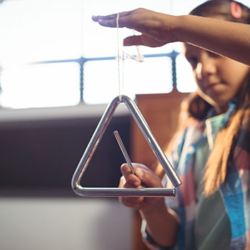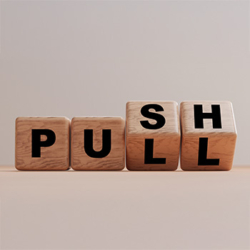 As kids, many of us have taken the time to set up a series of dominoes in a pattern just to watch them fall one after the other in a chain reaction. I was always fascinated to watch a display of how thousands of dominoes would be set into motion by a simple touch of just one domino. A pageantry of colors, shapes and designs lasting several minutes all started with one nearly effortless motion.
As kids, many of us have taken the time to set up a series of dominoes in a pattern just to watch them fall one after the other in a chain reaction. I was always fascinated to watch a display of how thousands of dominoes would be set into motion by a simple touch of just one domino. A pageantry of colors, shapes and designs lasting several minutes all started with one nearly effortless motion.
Here’s a video of 54,321 dominoes falling in some amazing patterns.
An ordinary domino is about 16/16 inch wide, 1 7/8 inches tall and 1/4 inch thick. A standard size domino can knock down a domino 1 ½ times its size with a bit of help from gravity and the fact that the prior domino is leaning on the one tipping forward.
In 1983 a study by the University of British Columbia physicist Lorne Whitehead and later showcased by University of Toronto Stephen Morris showed another aspect of the effect. Starting from a domino just five millimeters tall, Morris demonstrated that by increasing the domino by 1.5 times the previous domino, it would take only 29 progressively larger dominoes to topple the Empire State Building. Obviously, the Empire State Building was not actually knocked down. (Probably a permitting issue)
Often the domino effect is mentioned in more metaphorical terms.
Recently we have experienced the effect of policy concerning energy in the U.S. One seemingly small policy initiative can lead to larger and larger dominoes falling. While the policy has, as expected, led to high inflation, it may be that once the largest domino has been toppled, the net effect will be beneficial. I offer no guesses or theories on this as it is contrary to my economics 101 studies. Since those initiating the policy have degrees from prestigious institutions, I can only assume (hope) they are correct.
Each of us can think of how one small act leads to progressively larger consequences.
 The good news is that while we hear primarily of the bad things, the same domino effect is also true of good things. Simply think back to your youth of some small act of kindness or extra time of instruction from a parent or other concerned adult. It may have been many years later, but almost all of us have done something good for someone we can attribute to a lesson learned long ago. The person who influenced you may have given little effort from their perspective, yet it led to something good that you could then pass along. Since you already possessed skill, the helpful act on your part took little effort and still was multiplied years later.
The good news is that while we hear primarily of the bad things, the same domino effect is also true of good things. Simply think back to your youth of some small act of kindness or extra time of instruction from a parent or other concerned adult. It may have been many years later, but almost all of us have done something good for someone we can attribute to a lesson learned long ago. The person who influenced you may have given little effort from their perspective, yet it led to something good that you could then pass along. Since you already possessed skill, the helpful act on your part took little effort and still was multiplied years later.
It’s not about big things.
It may be picking up a piece of trash, returning your shopping cart, holding a door, helping someone with a project, paying for a stranger’s meal, or telling a cop, “thanks and stay safe.” All of these can represent a domino less than two inches tall. Ultimately you may have knocked down a domino the size of a skyscraper.
I did a quick search and found a number of articles that indicated helping others may be healthy for you. It may be about not only morality but mortality as well. While the studies used a variety of variables and had a variety of conclusions, none concluded that doing good was harmful. Put a sticky note on your dashboard that says, “do something good today.” If you don’t experience bad side effects, it’s probably ok to increase your dosage.
August 2022




